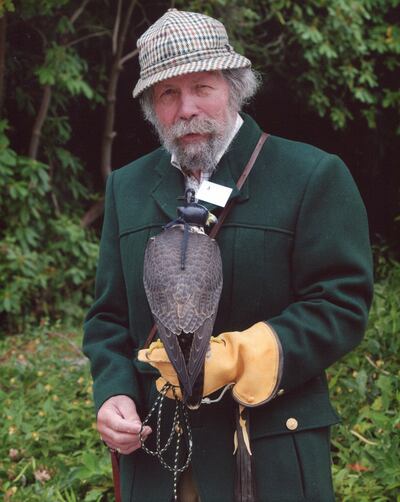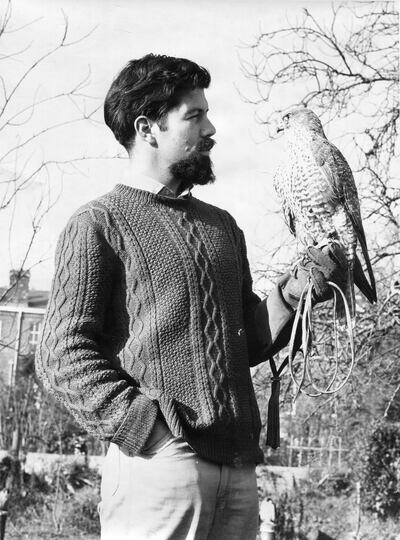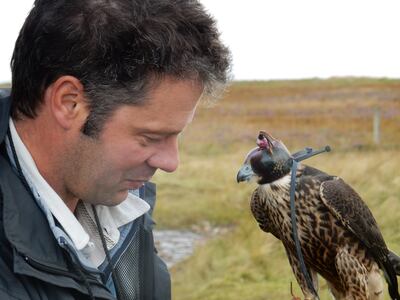In a clear blue sky a hawk circles, its keen eyes seeking out prey in the dunes and scrub of the desert floor below.
The sight is one that has not changed for centuries, because, with the cooler months arriving, thoughts in the Emirates turn to hunting with falcons.
Generations of Emiratis have bonded with the falcon, a Bedouin tradition embedded in the country’s cultural heritage.
But if the essence of falconry remains the same, the sport has changed beyond recognition in the past 50 years.
Saved from extinction
Captive breeding, artificial insemination, blood lines and even hawk passports are now central to the world of falconry. Birds that sweep through the skies over Arabia and Pakistan are as likely as not to have first tested their wings thousands of kilometres away, to be sold sometimes for thousands of dirhams.
As unromantic as this view of 21st-century falconry might seem, it has also helped to save nature’s ultimate aerial predator from near extinction in Europe in the 1960s.
“It was falconers who first noticed the decline in wild populations,” says Mark Upton, general secretary of the International Association for Falconry and Conservation of Birds of Prey (IAF).
“Environmental issues and pesticides in farming were killing them off wholesale. In Germany, the peregrine falcon had become extinct.”

Anyone with a knowledge of falconry, and particularly in the UAE, will know the surname Upton.
Mark’s father, Roger Upton, was a passionate chronicler of falconry and the author of several definitive books on the subject. In the 1960s he travelled to Abu Dhabi, where he became a close friend of Sheikh Zayed, hunting with him.
In 2017, the year of his death at 80, he was awarded a posthumous Abu Dhabi award, cited for preserving “an essential Bedouin custom that is not only a craft or a sport but a way of life that bridges cultural divides between Arab and western falconers”.
Rescuing the species
Mark remembers Sheikh Zayed visiting his father in the UK when he was five and visiting Abu Dhabi in 1976. Now a well-known artist specialising in wildlife, he breeds a small number of birds for family and friends and has now passed the family love of falconry to his own children.
It was falconers in Europe, with the support of men such as Sheikh Zayed, who rescued the population, he says.
Awareness of the loss of wild hawks means populations in Europe are now back at record levels. The IAF works in other countries, including Central Asia, another important breeding ground, to support conservation.
The organisation has strong links with the UAE, working with the Emirates Falconers Club, with Majid Al Mansouri, founder of the Abu Dhabi Falcon Hospital, as its president.
What really transformed the modern world of falconry, though, was a breakthrough in captive breeding in the early 1970s.
Before then, all falcons were captured as young birds in the wild. In Arabia, where falcons are winter migrants, “they would trap them, train them fast and then release them back in the wild”, Mark says.

This method actually improved the birds' chances of survival, improving their hunting skills and ensuring a good supply of food. “In the wild, 70 per cent to 80 per cent of birds die in their first year,” he says.
Hawks are notoriously difficult to breed in captivity and the skill needed to capture and train wild birds meant it was a niche sport. In the UK in the 1960s there were perhaps only 100 members of the British Falconers Club, and not all of them owned birds.
The Americans cracked captive breeding first, followed by Europe in the mid 1970s. Artificial insemination is one technique used, but many birds are hatched naturally.
Boom in the Middle East
Falcons breed only once a year, in the spring, prompted by the lengthening days, although it is possible to produce a second clutch of eggs by removing and incubating the first.
Chicks born in captivity are far more likely to survive than in the wild, and the birds are easier to train from birth. Captive breeding also takes the pressure off wild populations.
With birds becoming available for sale in greater numbers, there was a boom in the popularity of falconry, and no more so than the Middle East and the countries of the Arabian Gulf.
Coincidentally, the 1970s were also a time when oil revenues were transforming the fortunes of the Gulf Arabs.
Enjoying money and leisure for the first time, Emiratis could reconnect with a Bedouin culture that transformed hunting with hawks, once an essential source of meat in a harsh desert environment, into an enjoyable sport.
Demand from the Gulf means falcon breeding has become a thriving business. Prices for a single bird start at about £2,000 (Dh8.300, about $2,240) but size, looks and even blood lines can push this much higher.
Still, says Mark Upton, “high prices of hundreds of thousands are very unusual”.
More common is some Gulf Arabs buying 20 or 30 birds at a time as gifts for their friends. A hunting camp in the UAE might have as many 100 birds taking part.
Strict conservation

The interest and popularity of falconry goes hand in hand with strict conservation rules designed to prevent birds being snatched in the wild.
Each bird is issued with individual papers to prove it has been bred in captivity under the Convention on International Trade in Endangered Species of Flora and Fauna.
Without this “falcon passport” it cannot cross international borders or enter the UAE.
The IAF, which now has members in 86 countries, plays a wider role in supporting conservation. The houbara bustard, a chicken-sized bird and desert prey for falcons, also suffered huge population decline by the turn of the century, the result of habitat loss and hunting with guns.
In 2006, the International Fund for Houbara Conservation began a breeding programme that has led to tens of thousands of birds being reintroduced in the wild, including the UAE, North Africa and Pakistan.
And while the falcon is no longer endangered in Europe, dangers still exist elsewhere in the world. Power lines were estimated to be electrocuting up to 4,000 saker falcons a year in Mongolia as well as numerous other birds of prey, including eagles.
Power lines, described by the IAF as “24/7 killing machines”, can be neutralised with a simple and inexpensive insulator.
To thrive and survive, falcons, it seems, still need the help of mankind, an even more deadly predator.



















